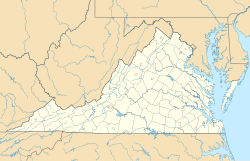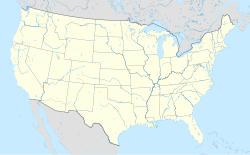Washington and Lee University Historic District
Washington and Lee University Historic District | |
 | |
| Location | Washington and Lee University campus, Lexington, Virginia |
|---|---|
| Coordinates | 37°47′9″N 79°26′39″W / 37.78583°N 79.44417°W |
| Built | 1824 |
| Built by | John Jordan, Samuel Darst |
| Architectural style | Greek Revival |
| NRHP reference No. | 71001047 |
| Significant dates | |
| Added to NRHP | November 11, 1971[1] |
| Designated NHLD | November 11, 1971[2] |
The Washington and Lee University Historic District is a National Historic Landmark District encompassing the historic core elements of the campus of Washington and Lee University in Lexington, Virginia. The campus's Colonnade constitutes one of the nation's finest assemblages of Classical Revival educational buildings, and includes Washington Hall, the school's oldest surviving building. The district also includes University Chapel, itself a National Historic Landmark. The district was listed in 1971.[2][3]
Description and history
[edit]Washington and Lee University was founded as Augusta Academy in 1749. Washington Hall, its oldest surviving building, was built in 1824 by John Jordan, a self-taught builder. It is a three-story brick building distinguished by a six-column Doric portico and a cupola topped by a statue of George Washington. Its flanking wings are also fronted by portico styling. This colonnaded Classical style set the tone for later buildings on the campus, including Newcomb Hall and Tucker Hall, which stand on either side. Newcomb, a Late Victorian building, was modified in the 1920s to conform to the Washington Building's style, and Tucker Hall was added in 1935. Flanking the three central buildings are two pairs of faculty residence halls built in 1843, each the four-column Greek Revival porticos.[3]
This row of buildings occupy the top of a roughly north-south ridge. Down the hill to the east stands Lee Chapel, named for Robert E. Lee, who served as Washington College's president and is interred in a crypt within. After Lee's death, the school was renamed Washington and Lee to also honor his role in raising the school's status.[3]
In 1926, the poet and dramatist John Drinkwater, author of Robert E. Lee and other plays, wrote of W&L, "This Lexington university is one of the loveliest spots in the world."[4] Jonathan W. Daniels, North Carolina author, newspaper editor and White House Press Secretary to President Franklin D. Roosevelt, wrote that it was "the South at its most beautiful: the green sloping campus to the red-brick buildings with the tall white porticoes....I wish it were the picture of the South. I wish, indeed, it were the picture of America."[5] Washington and Lee History Professor Ted DeLaney, who was born and grew up in Lexington during Jim Crow and spent more than 45 years of his 60-year career at W&L, more than a quarter-century as a professor, including serving as the first Black chair of the History Department, said in 2019, "W&L is unique because the entire campus is a Confederate monument."[6]
See also
[edit]- List of National Historic Landmarks in Virginia
- National Register of Historic Places listings in Lexington, Virginia
References
[edit]- ^ "National Register Information System". National Register of Historic Places. National Park Service. January 23, 2007.
- ^ a b "Washington and Lee University Historic District". National Historic Landmark summary listing. National Park Service. Retrieved April 23, 2008.
- ^ a b c Unsigned (n.d.). "National Register of Historic Places Inventory-Nomination: Washington and Lee University Historic District" (pdf). National Park Service. and Accompanying 5 photos, exterior and interior, from 1969 and 1971 (32 KB)
- ^ "Drinkwater pays tribute to W. & L." (PDF). The Ring-tum Phi. February 17, 1926. pp. 1, 4. Retrieved March 18, 2021.
- ^ Daniels, Jonathan (November 1941). "Seeing the South". Harper's.
- ^ Covington, Abigail (November 4, 2019). "What Do We Do With Robert E. Lee?". The Delacorte Review. Retrieved March 14, 2021.
External links
[edit]- Washington and Lee University, Lexington, one photo at Virginia DHR
- Historic American Buildings Survey (HABS) No. VA-568-A, "Washington & Lee University, Washington Hall, Jefferson Street, Lexington, Lexington, VA", 4 photos, 8 data pages, 1 photo caption page
- HABS No. VA-568-B, "Washington & Lee University, Lee-Jackson House, 4 University Place, Lexington, Lexington, VA", 2 data pages
- HABS No. VA-568-C, "Washington & Lee University, Lee Chapel, Lexington, Lexington, VA", 10 photos, 10 data pages, 1 photo caption page
- National Historic Landmarks in Virginia
- Historic American Buildings Survey in Virginia
- Geography of Lexington, Virginia
- Washington and Lee University
- Historic districts on the National Register of Historic Places in Virginia
- National Register of Historic Places in Lexington, Virginia
- Brick buildings and structures in Virginia




